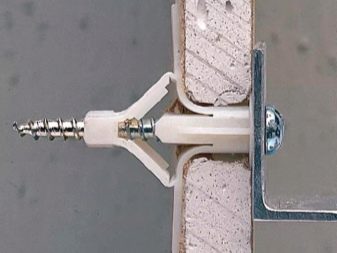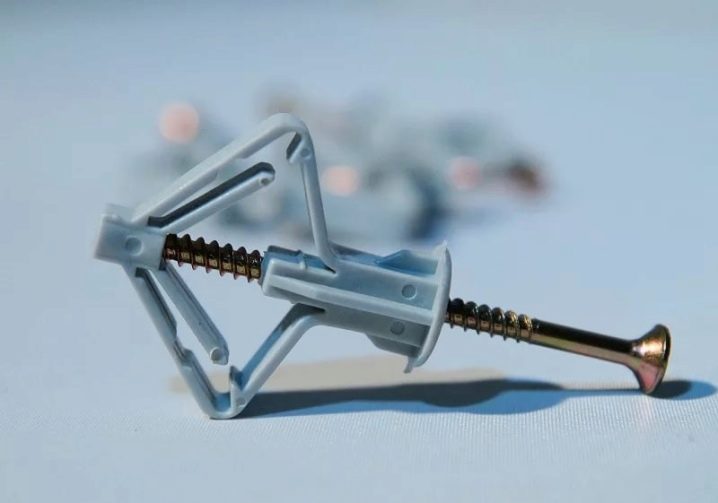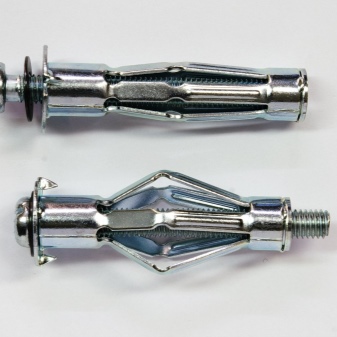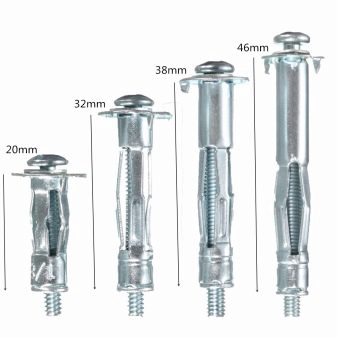Butterfly dowel for drywall: features of choice

Plasterboard is a popular material among decorators that can be used for different rooms and different needs. It is used for leveling walls, creating various structures and many other purposes. Plasterboard walls are very different from concrete or brick walls. Therefore, for such hollow structures, special dowels were invented that can withstand the weight of heavy objects. Most often, the so-called butterfly dowel is used for attachment to a plasterboard base, which is considered the most suitable type of fittings for such walls.


Peculiarities
The butterfly dowel is a type of construction fastener designed to securely fix such interior and household items as shelves, paintings, chandeliers and lamps, TVs, and various types of plumbing on a plasterboard wall. It has a wide bi-directional design and consists of a spacer and a static part. The spacer part is placed in a hole made in the plasterboard structure, at the moment of screwing in the threaded fastener, it expands, due to which the connection becomes strong. The dowel has a border that prevents it from sinking into the depth of the plasterboard structure.

The butterfly dowel for drywall boasts an impressive set of advantages over other types of fasteners:
- often goes on sale complete with a self-tapping screw that suits it in terms of parameters;
- convenience and simplicity of installation work;
- can be used to fasten one or more sheets of drywall;
- securely fixed in drywall due to the ribbed surface;


- even distribution of the load exerted by an object attached to a drywall sheet;
- the thread applied to the far head of the dowel helps a reliable clamp, and the special lugs located inside ensure good strength of the entire structure, exclude twisting, provided that the dowel is fully screwed in;
- can be used repeatedly, while its repeated use has absolutely no effect on the quality of work;
- long service life;
- versatility that makes it possible to use it for chipboard (chipboard), plywood and many other building sheet materials.


Views
Dowels can be divided into subspecies.
- Checkpoints... They are used for fixing to the ceiling. They are ideal for installing massive chandeliers or sports equipment.
- Unclenching... Used for hanging household items and interior no heavier than 15 kg.
Butterfly dowels are made from different materials. In particular, they can be plastic, metal and nylon.


The most widespread are plastic butterflies. They owe their appearance to the invention of Arthur Fisher in 1958. Plastic butterfly dowels have a low cost, which makes them popular with consumers. In turn, plastic and nylon plugs are resistant to rust. Their disadvantage is that it is undesirable to hang heavy objects on them.
Metal dowel-butterflies at a price they significantly exceed their plastic counterparts, but they also withstand a much greater load: up to several hundred kg. The ability to support a lot of weight increases with the use of double drywall. Some manufacturers coat them with a special "anti-rust" compound, which prolongs the life of the fasteners.The metal butterfly is also called the "molly" dowel. They have the following characteristics: self-tightening fasteners, L-shaped projection, ring dowels, hook projections.


For work with drywall can also be used anchor bolt... A wedge anchor with lateral wedging is best suited for this material. The peculiarity of its structure is also that it is made of a metal hairpin with a groove for a wedge and a thickening at the end. Once installed, the wedge anchor cannot be dismantled.
For installation work, the purpose of which is to fix the metal profile, chandelier, shelves to drywall, it is very often used dowel nail... These fasteners can be of different sizes. For drywall, a dowel-nail with a size of 6x40 mm is mainly used.


How to install
Drywall is known as a finishing material with not the highest strength. In the process of work, it can crack, break and crumble. But since it is easy to install, builders love to use it in their work. In order not to subject the plasterboard wall to mechanical destruction, a butterfly dowel was created. With its help, installation to drywall can be performed not only by experienced specialists, but also by beginners.

Most often, such fasteners are used when it is necessary to hang a shelf or a heavy picture on a drywall wall. Securely fixed in the wall, the butterfly dowel can withstand a structure weighing up to 10 kg. Provided that the wall is made of two layers of gypsum board, you can hang an object up to 25 kg on it.
It is very easy to screw a butterfly dowel into drywall. This is done, as a rule, in a couple of minutes. Wherein to carry out quality work, you need to adhere to some rules:
- First you need to determine the place of attachment, assess the complexity of the work and choose the required type of dowel-butterflies. You should not be surprised that there may not be self-tapping screws or screws in the kit - they will need to be purchased separately.

- Usually, dowels are bought with a small margin. Their versatility lies in the fact that it is possible to fasten the butterfly dowel not only to drywall, but also to many other materials.
- It is best to make markings, along which the installation of dowels will then be carried out, using a building level. This will help to avoid mistakes in work.
- Drilling drywall must be done with a drill. For punching, you can use a wood drill. It will be more convenient to drill with a screwdriver.
- Before starting drilling, you must make sure that the screwdriver works with the impact mode disabled.

- The hole must be sized to accommodate the plastic dowel. Usually it is made 4 mm larger than it, since it should expand slightly when the self-tapping screw enters it.
- A fastening element is put on the self-tapping screw, on which the desired object is subsequently suspended.
- The dowel is clamped with fingers and threaded into the hole drilled in advance, up to the fastener head. Then you should tighten the screw.
- The self-tapping screw is required to be tightened until it is firmly fixed. This is the only way to expand the dowel components to the maximum and securely fix on the plasterboard wall. At the same time, the use of a screwdriver in the installation significantly reduces the likelihood of thread breakage in plastic.
- Then, with a little effort, you need to pull on the external fasteners. In this way, the firmness of the fastening can be checked.

Advice
The choice of fasteners for drywall should take into account the constant load that it can withstand. In addition, we must not forget that some types of fasteners cannot be unscrewed without destroying the existing structure, therefore, it is necessary to clearly and accurately mark up.
It is worth noting that butterfly dowels are made in different sizes, but the most popular are 9x13 mm and 10x50 mm.It should be remembered that for full disclosure of the butterfly dowel, you need to take a self-tapping screw no more than 55 mm long. In addition, the masters are advised to take into account the distance between the drywall and the wall.


The thickness of the item to be fastened with a butterfly is limited. As a rule, it is possible for them to attach a fastener with a thickness of no more than 5 mm to the wall, on which the piece of furniture will be held.
Sometimes it happens that the length of the butterfly dowel and the self-tapping screw turns out to be larger than the space behind the plasterboard. In this case, a recess is drilled with a drill in the wall, which allows the fasteners to be fully installed.


When drilling on the ceiling, it is recommended to use a disposable glass that is worn over the drill. This little trick will allow you to avoid cleaning the room from debris that will fall in the process.
Experts advise the material from which the dowels are made to be checked for elasticity. Fasteners made of too hard plastic are more prone to fractures than others, so they can break immediately when fastened.

For the features of choosing a butterfly dowel for drywall, see the following video.













The comment was sent successfully.